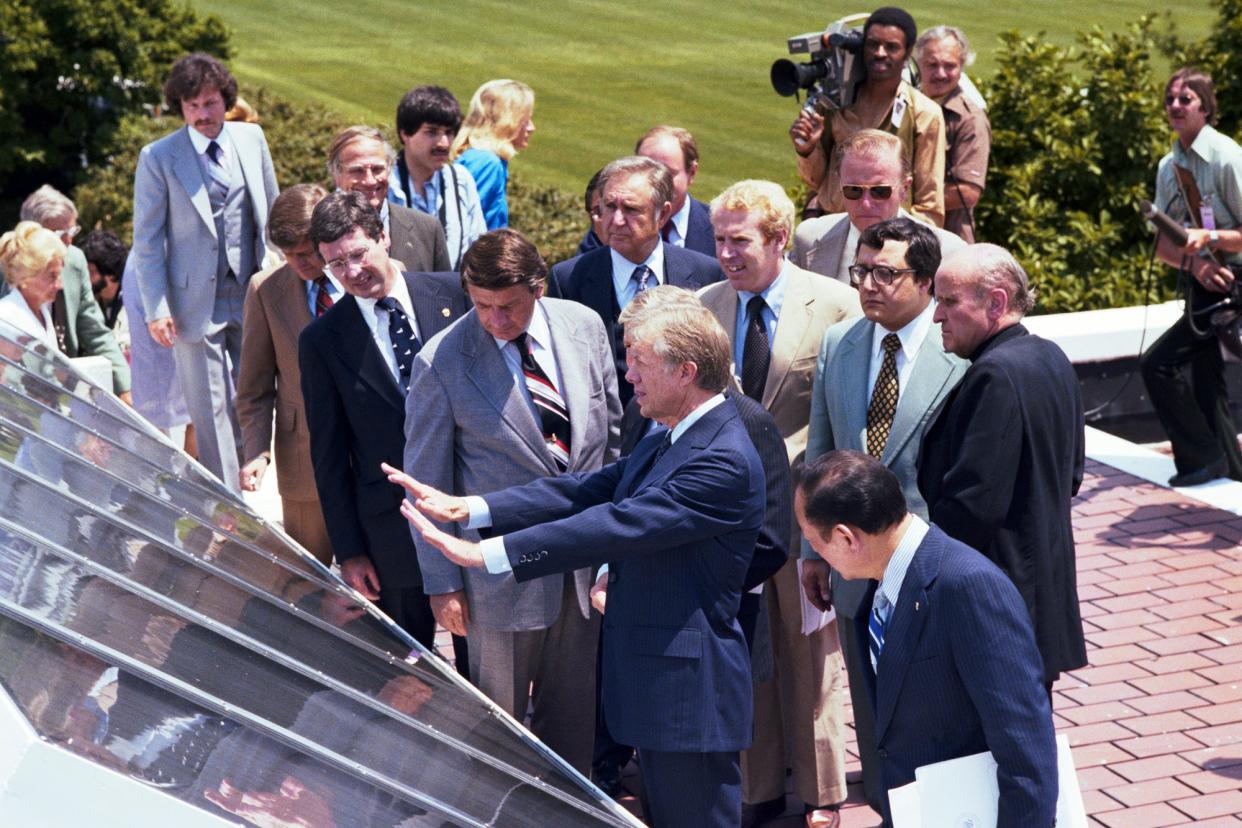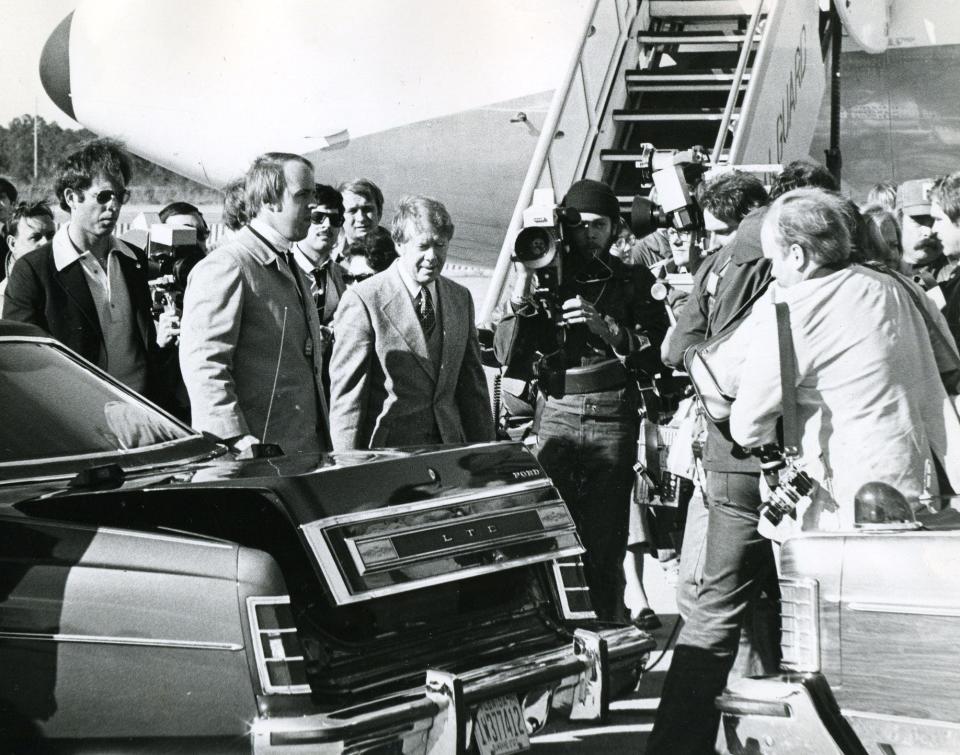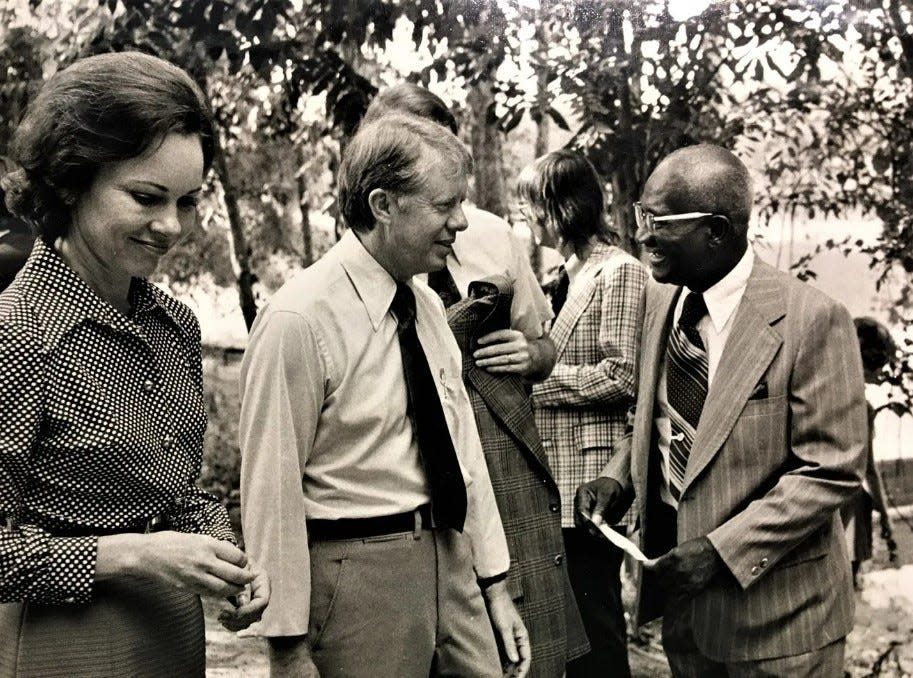Solar, parks and rivers speak to Jimmy Carter's environmental legacy in Georgia

- Oops!Something went wrong.Please try again later.
Editor's note: This article was updated to reflect that the Flint River is not a nationally recognized wild and scenic river, that is the Chattooga River. It has also been updated to include information about the preservation of the Wormsloe Historic Site.
A picture of Jimmy Carter is making the rounds online. It's June 1979, and then-U.S. President Carter is standing on the White House lawn surrounded by many other men in suits, all huddled close in front of a long, rectangular slice of solar panels.
The president from Plains, Georgia, who at age 98 recently entered hospice care, is known for a lot of things: his love of his hometown, his penchant for hammering away with Habitat for Humanity and peanuts. But hand-in-hand with his ever-growing list of presidential, naval and civilian accomplishments is his legacy as a staunch conservationist who helped shape some of Georgia's most important natural spaces as well as its nascent renewable technology industry.
Here are some of the ways Carter's environmental legacy persists in Georgia:
Entering hospice: Former President Jimmy Carter enters hospice care at 98, charity says
Presidential museum: Visitors to Jimmy Carter Presidential Library pay respects, take in his remarkable life

An early adopter of solar
"If you look at a line graph from when Carter took office to today, most of the cuts — over half the cuts — in the price of solar took place when Carter was president," said Jay Hakes, a historian who focuses on energy and presidents.
Hakes ran Carter's election campaign in Louisiana and worked in his administration in Washington, D.C. He went on to be president Bill Clinton's head of the U.S. Energy & Information Administration, was the director of research and policy for President Barack Obama's BP Deepwater Horizon Oil Spill Commission, and also served as the director of the Jimmy Carter Library and Museum from 2000 to 2013.
Solar panels in the 1970s aren't like their modern descendants. The ones Carter put on the White House, which president Ronald Reagan took down just a few years later, were thermal solar panels where chemicals run through the panel and heat water as opposed to modern photovoltaic panels.
A Plains life:Growing up in Plains, Georgia shaped Jimmy Carter, just as he shaped his hometown
"It's kind of a dinosaur technology," Hakes said. But the U.S. wouldn't have gotten to where it is today with solar panel development without Carter. He said that beyond founding the U.S. Department of Energy, Carter invested heavily in the research and development of solar technology during a time period when oil and energy independence from the Middle East were top national priorities.
"It's clear from the record that Carter realized that solar really wasn't going to be market competitive until at best late in the 20th century," Hakes said. "So he would get no political benefit from it in the conventional sense."
Hakes said Carter went and visited the Solar Energy Research Institute in Colorado, now called the National Renewable Energy Laboratory, and a scientist told him many people thought of solar as a "hippie thing," but the president's support in the research helped lend credibility.
Hakes said that Carter struck some as naive, but he didn't think Carter was naive at all. Rather, he said Carter just operated from a different value system that "you couldn't just devour nature" and then win the next election, passing environmental degradation onto children and grandchildren.
Since 2017, the Carter Family's land in Plains has housed more than 3,800 solar panels which produce enough electricity for about half of the town.

Land conservation for parks, wilderness
In 1967, Carter became a charter member of the Georgia Conservancy, a conservation organization working on ecological and economic solutions for stewardship, conservation and sustainable land use. Brian Foster, communications director for the Georgia Conservancy, said Carter's background as a child in Plains, growing up outdoors helped form a lifelong environmental ethic he carried with him throughout his time in government and beyond.
"If you know anything about the environmental movement, the late 1960s was the firestorm hot and every organization you could think of that as environmental impact right now (in Georgia) was founded," said Foster. The big issues to conservationists at the time had to do with sprawling metro Atlanta's development into nature, but beyond that Foster said Carter had big impacts throughout the state.
With the early Georgia Conservancy, Foster said Carter helped advocate for the establishment of Cumberland Island National Seashore, wilderness designation for the Okefenokee Swamp and creation of the Sweetwater Creek State Park along with his fellow members of the Georgia Conservancy.
Preservation of Savannah area gems
In 1972, Carter founded the Georgia Heritage Trust which was key to identifying locations throughout the state in need of conservation. As governor, he created the trust to accept approximately 800 acres of land from the Wormsloe Foundation to create the Wormsloe Historic Site, known for its famous archway of live oaks.
From the trust, Foster said, also came the protection of Ossabaw Island on the coast of Georgia.
According to a press release from the Ossabaw Island Foundation, the late Mrs. Eleanor "Sandy" Torrey West, of the family that sold the island to the state for protection, said that Carter was essential to her family's decision to sell the island.
"He was the only one that came down and said, 'You tell me what should be done.' You know everybody else said, 'You read this (or) you do that,' and sat in the living room and didn't even go out and see anything," Torrey West said in a video interview. In 1975, Carter signed the State Heritage Preserve Act into law and Ossabaw was the first acquisition of the Georgia Heritage Trust.
Parks and preservation
With the same Heritage Trust program, in the Atlanta area, Foster said Carter also added acreage to the land set aside for Panola Mountain State Park, a space just east of Atlanta the Georgia Conservancy played an active role in protecting. Moreover, he helped set aside 300 acres along the Chattahoochee River that would become part of the modern Chattahoochee River National Recreation Area.
Beyond Georgia, Carter is also celebrated for signing the Alaska National Interest Lands Conservation Act in 1980, which established 162,500 square miles of national park lands in Alaska.

Water protections in Georgia and beyond
Once he became governor, Foster said Carter vetoed a water reclamation project on the Flint River that would have dammed the river, a project supported by the U.S. Army Corps of Engineers.
The dam would have threatened native species such as the shoals spider-lily and shoal bass, but the prevention of the dams has maintained the Flint River as a free-flowing resource for Georgians. As governor, Carter helped push policies to establish the Chattooga River as a nationally designated Wild and Scenic River which would prevent future dam building and development.
Learning from this experience, Foster said as president Carter went on to de-authorize more than 16 national water reclamation projects that would have harmed riverways.
Marisa Mecke is an environmental journalist. She can be reached at 912-328-4411 or mmecke@gannett.com.
This article originally appeared on Savannah Morning News: Jimmy Carter environmental legacy, land, water and energy protections

